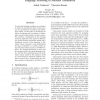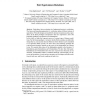120 search results - page 5 / 24 » A Word-to-Word Model of Translational Equivalence |
CORR
1998
Springer
13 years 7 months ago
1998
Springer
A model of co-occurrence in bitext is a boolean predicate that indicates whether a given pair of word tokens co-occur in corresponding regions of the bitext space. Co-occurrence i...
NIPS
2008
13 years 8 months ago
2008
We present a novel method for inducing synchronous context free grammars (SCFGs) from a corpus of parallel string pairs. SCFGs can model equivalence between strings in terms of su...
ACL
2008
13 years 8 months ago
2008
In statistical language modeling, one technique to reduce the problematic effects of data sparsity is to partition the vocabulary into equivalence classes. In this paper we invest...
ACL
2008
13 years 8 months ago
2008
Large-scale discriminative machine translation promises to further the state-of-the-art, but has failed to deliver convincing gains over current heuristic frequency count systems....
BIRTHDAY
2003
Springer
14 years 19 days ago
2003
Springer
Equivalence between designs is a fundamental notion in verification. The linear and branching approaches to verification induce different notions of equivalence. When the designs...


